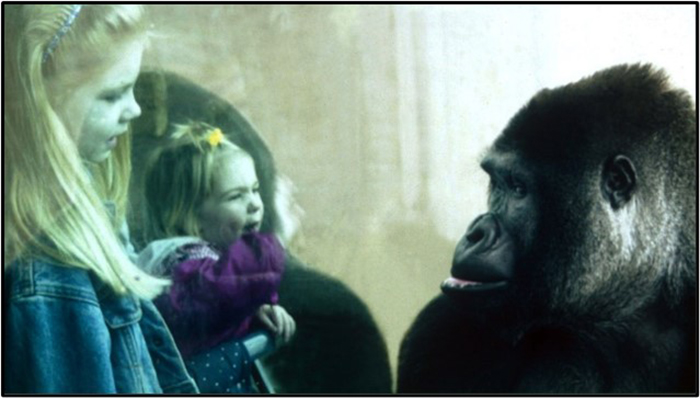Visitor Experience/Education
Visitor Experience/Education
Research shows most zoo and aquarium visitors come to experience a “pleasant day out” with family and friends. How can this be provided, yet enlarged to also produce deep learning, the types of learning leading to pro-environmental changes and advocacy? There are many ways to learn. Emotional (affective) learning seems most important because science shows it is both strongly linked to choice and satisfaction and that people tend to make decisions based on emotion more often than on data (cognitive learning). This section discusses blending several learning approaches in support of the critical question: “What’s the message” the institution wishes to communicate both emotionally (subliminally) and cognitively (through information provided). This message needs to be effectively communicated not only to visitors, but also to staff, supporters, critics and to the local and international community.

Learning is emotion driven. Many modern zoos use the “Connect-Underact-Act” mantra developed in 2009 by Rachel Lowry, then at Zoos Victoria, to guide their visitor experience & education initiatives. (Photo: Philadelphia Zoo).
“Those who think there is a difference between entertainment and education don’t understand either one.”
Marshall McLuhan
“Exhibits are a zoo’s natural voice” Jon Coe
How can exhibits inspire positive change?
“To inspire, we should arouse the emotions of our visitors
by providing Memorable Experiences” (Liam Smith)
3 Steps to Action:
Feelings (affective): Emotional learning comes first!
Knowing (cognitive)
Doing (behavioural)
What’s the message (explicit and implicit)?
Feeling + Knowing + Doing = Message
Connect + Understand + Act (Zoos Victoria educational method)
Deep emotion + Deep thinking = Attitude Change + Action. (Petty and Cacioppo)
Design to Optimize Both Visitor and Animal Experiences
The visitor is one focus of zoo design but every approach to zoo exhibition also effects caregiver and animal wellbeing. Both “Natural Habitat” and “Functional Naturalism”, when well done, have animal welfare at their core, based of course on human understanding at the time of development. Later approaches, such as “Activity-Based Design”, “Affiliative Design”, “Animal Rotation and Trailways” were created to optimize animal welfare while also benefiting viewers. Today design emphasis has passed from visitor experience to animal welfare, but good design has always benefited both.
Theme & Story
Overall thematic organization of zoos was developed by Carl Hagenbeck in 1907. Storylines, narratives which add interest and continuity to groups of displays, emerged from simple storytelling and theatrical and cinematic productions. Both themes and storylines had major impacts on zoo displays through their dramatic use at Disney’s Animal Kingdom in Florida, USA, and other leading theme parks. The use of themes and storylines have added more depth to the concept of immersion design in recent years.

Jon Helped Zoo Atlanta reinforce the storyline of their African Plains exhibit by creating a cartoon character, “Mr Zuma, African Park Warden” played by a talented Atlanta area actor who would walk around the exhibits interacting with visitors and staging a mock trial in the Elder’s Tree Theatre of another actor playing the part of a “poacher”. We called this “Habitat Theatre”.
Storylines “…place each exhibit and related groups of exhibits in a consistent environmental context. They establish fundamentals and prescribe an approach which when understood and followed will produce exhibits appropriate and responsive to their intent.” Quoted from Woodland Park Zoo Long-Range Plan, Development Guidelines and Exhibit Scenarios, Jon Coe was a co-author of this Jones & Jones master plan in 1976.
Read more about Visitor Experience and Education
Coe, Jon. C., 1982. “Bringing It All Together: Integration of Context, Content and Message In Zoo Exhibit Design” in AAZPA 1982 Annual Conference Proceedings, American Association of Zoological Parks and Aquariums, Wheeling, WV, pp. 268-274. Abstract
Coe, Jon C., 1985. “Design and Perception: Making the Zoo Experience Real” in Zoo Biology, vol. 4 no. 2, pp. 197-208.
Coe, Jon C., 1987. “What’s The Message? Exhibit Design for Education” in AAZPA 1987 Regional Conference Proceedings, American Association of Zoological Parks and Aquariums, Wheeling, WV, pp. 19-23. Abstract
Coe, Jon C., 1988. “How Should We Manage the New Exhibit Technology? ‘Soft’ Technology” in AAZPA 1988 Annual Conference Proceedings, American Association of Zoological Parks and Aquariums, Wheeling, WV, pp. 51-58.
Coe, Jon C., 1989. “Children’s Drawings May Make Good Evaluation Tools for Zoo Exhibits” in Visitor Studies 1988: Theory, Research and Practice, S. Bitgood, J. Roper, A. Benefield, Eds. Center for Social Design, P. O. Box 1111, Jacksonville, Alabama 36265. Abstract
Coe, Jon C., 1991. “An Integrative Process for Exhibit Design” in Journal of Museum Education. Abstract
Coe, Jon C., 1999. “Increasing Affiliative Behavior between Zoo Animals and Zoo Visitors” in 1999 AZA Convention Proceedings, American Zoo and Aquarium Association, Silver Spring, MD, pp. 216-220. Abstract
Additional Reading:
Lowry, R & Gray, J. (2009) “Using Conservation Education to Bring About Behaviour Change“. World Association of Zoos and Aquaria.